
Gear > Backcountry Snowboarding > Snowshoes
Snowshoes are probably the most common climbing aid used by off-piste snowboarders as they require no special skills to use. It is as simple as walking, well almost. Modern plastic snowshoes are lightweight and not particularly expensive and are pretty much unbreakable. Basically snowshoes increase the surface area of the foot and therefore overcome the problems of deep snow. Obviously a smaller snowshoe will have less floatation, this can cause problems for heavier riders in deep powder. Snowshoes must be carried for the descent, rucksacks exist specifically for this purpose. Hard boots work well with snowshoes that have mountaineering style bindings and these can be used on steeper slopes.
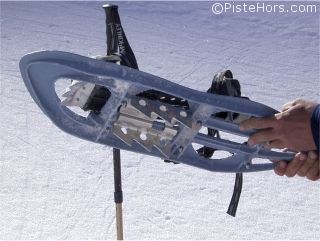
Snowshoe Crampons with TSL snowshoes
Some snowshoes can take crampons (known as couteaux or harscheisen in France and Germany). These attachments bite into the surface and enable the user to climb steeper slopes especially when the surface snow is hard or frozen. The bottom of the shoe is normally equipped with a number of sharp points to help grip and the front of the binding may have metal points to further aid when climbing.
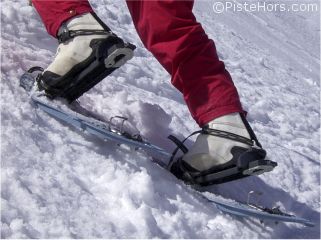
Climbing steeper slopes requires good technique
Soft boots can be used with most snowshoes with strap fixings. The principal disadvantage of snowshoes is that it takes some technique to climb steeper slopes; this can mean a long detour or climbing on foot. In general an experienced user should be able to climb 35° to 45° slopes depending on conditions. About the same as a skier. The board should be strapped to a rucksack when climbing. The best snowshoes are fairly narrow and short. They should also be durable; a broken snowshoe far from civilisation can be a nightmare, the aluminium Tubbs snowshoes have a reputation for robustness and TSL plastic shoes are also very good.
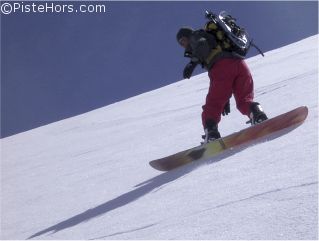
Shoes and Poles are carried for the descent
For soft-boot users, the TSL 225 Freeride system includes a snowshoe binding that can adapt to most snowboard boot bindings on the market. The binding has a front claw to grip on ice and a heel lock. Using a clicker type binding simplifies getting into and out of snowshoes and increases the security and thus the steepness of slope that can be climbed.
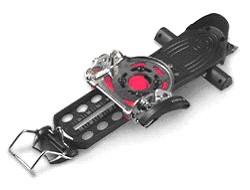
TSL 225 Freeride Binding
The 600 gram binding can either be used with the TSL 225 snowshoe or with the Duotone snowshoe. Both TSL and Duotone also provide a snowshoe crampon (harscheisen) for security in icy conditions.
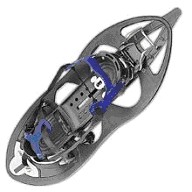
Duotone Snowshoe
Hard shell boots work with rapid mountaineering style bindings found on snowshoes, crampons and approach skis. They usually have a grippy rubber (Vibram) sole and an inner boot, which can be removed for drying when over-nighting in a refuge. Soft boots are more comfortable but they need to be good quality, waterproof (Goretex type lining) with a good sole for walking.
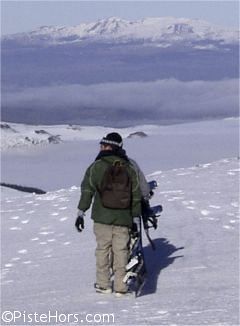
On hard snow you may be able to walk
When climbing on foot without snowshoes the board is carried, dragged on a long leash or strapped vertically to a specially adapted rucksack. The latter is the best option as it leaves hand free to use a pair of poles. While it is practical to climb on well consolidated spring snowpack the winter powder conditions most favoured by boarders render this almost impractical for any but the shortest or most well trodden slopes.
<< Leading Backcountry Snowboard Groups | Backcountry Snowboarding | Approach Skis >>